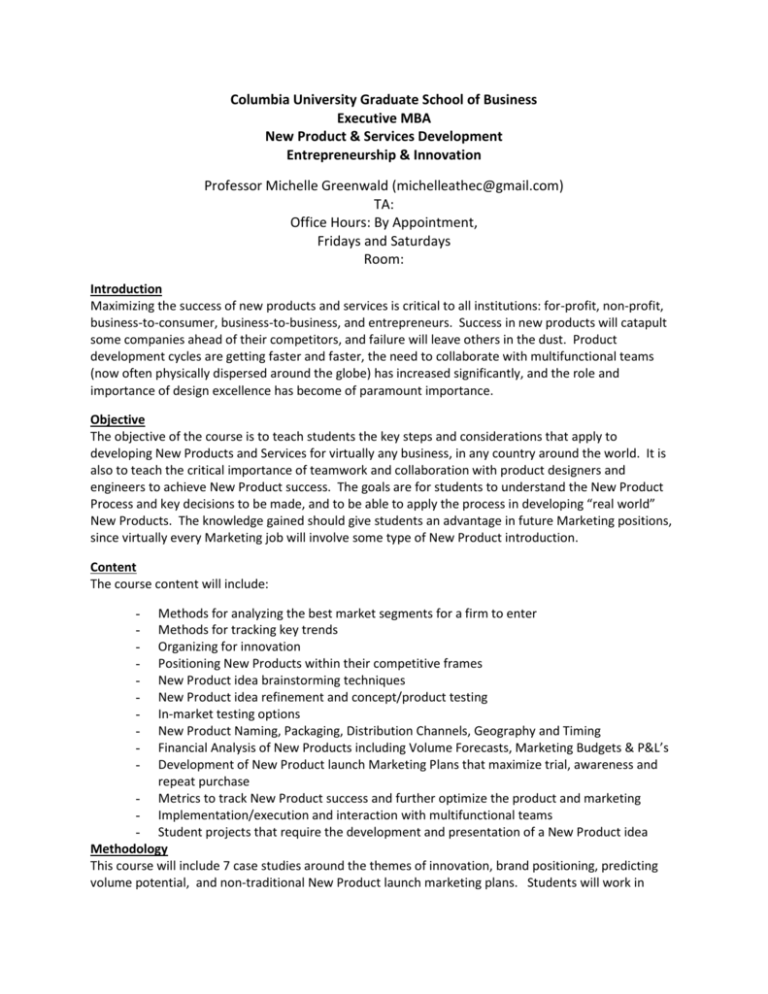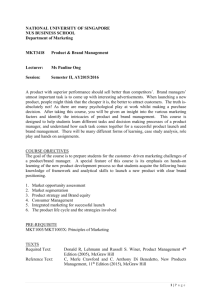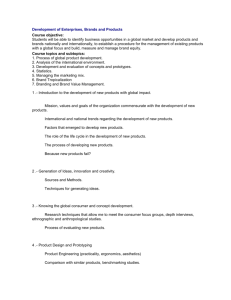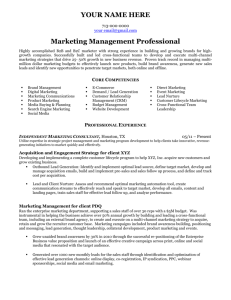Syllabus - Columbia University
advertisement

Columbia University Graduate School of Business Executive MBA New Product & Services Development Entrepreneurship & Innovation Professor Michelle Greenwald (michelleathec@gmail.com) TA: Office Hours: By Appointment, Fridays and Saturdays Room: Introduction Maximizing the success of new products and services is critical to all institutions: for-profit, non-profit, business-to-consumer, business-to-business, and entrepreneurs. Success in new products will catapult some companies ahead of their competitors, and failure will leave others in the dust. Product development cycles are getting faster and faster, the need to collaborate with multifunctional teams (now often physically dispersed around the globe) has increased significantly, and the role and importance of design excellence has become of paramount importance. Objective The objective of the course is to teach students the key steps and considerations that apply to developing New Products and Services for virtually any business, in any country around the world. It is also to teach the critical importance of teamwork and collaboration with product designers and engineers to achieve New Product success. The goals are for students to understand the New Product Process and key decisions to be made, and to be able to apply the process in developing “real world” New Products. The knowledge gained should give students an advantage in future Marketing positions, since virtually every Marketing job will involve some type of New Product introduction. Content The course content will include: Methods for analyzing the best market segments for a firm to enter Methods for tracking key trends Organizing for innovation Positioning New Products within their competitive frames New Product idea brainstorming techniques New Product idea refinement and concept/product testing In-market testing options New Product Naming, Packaging, Distribution Channels, Geography and Timing Financial Analysis of New Products including Volume Forecasts, Marketing Budgets & P&L’s Development of New Product launch Marketing Plans that maximize trial, awareness and repeat purchase - Metrics to track New Product success and further optimize the product and marketing - Implementation/execution and interaction with multifunctional teams - Student projects that require the development and presentation of a New Product idea Methodology This course will include 7 case studies around the themes of innovation, brand positioning, predicting volume potential, and non-traditional New Product launch marketing plans. Students will work in - teams to develop and present their New Product concept to the class. This will include Upfront Research about the category (size, growth, segments, trends, competitive products), concept boards, Marketing Research among target consumers to refine the idea, a test market roll-out recommendation, introductory launch marketing ideas, and a 5 year P&L with expansion plans and a sensitivity analysis. Evaluation 35% of the course grade will be based on class participation, which will include attendance, case discussions, questions, insights, and sharing relevant experience. 65% of the grade will be based on a group project that is explained in detail, following the key deliverables due dates. Brief Faculty Bio Michelle Greenwald was a Vice President & General Manager of New Products at Pepsi-Cola and a Senior Vice President of New Products for Disney. She’s Forbes Innovation blogger, wrote a column on innovation for Inc.com, and a book on Innovation: Catalyzing Innovation. She has taught New Products & Services Development and Entrepreneurship & Innovation for years for graduate business schools globally and in the U.S., including Wharton and NYU Stern, as well as for the American Marketing Association. She consults on New Product Development as well. Key Deliverables Due Dates ONLY: (Does Not Include Each Class Topic) SEE FOLLOWING SECTION OF SYLLABUS FOR A CHECKLIST OF THE CONTENT WE WILL COVER! Session 2 Form teams, select a topic & provide a 1-paragraph description of your idea. Include the team member names & e-mail addresses Session 3 Team Concept Board Presentations to Class Librarian to present information data sources Session 3 Case Discussion El Bulli: Innovation process & techniques Case Write-Up In no more than one page, written, single-spaced, provide your perspective on the following case questions: Which aspects of El Bulli’s New Product/food/dish development process foster creativity & innovation? Which of these factors do you believe can & cannot be applied to the corporate world? Session 4 Assignment: Ways to vary attributes for your new products based on Catalyzing Innovation book Marketing research questionnaire questionnaires due. Guest Speaker: Eliot Sandy Brown, Partner ReD Associates, the leading global cultural anthropology firm Session 5 Visit to Smart Design (Industrial Design Firm) 601 West 26th Street 18th floor New York, NY 10001 (212) 807-8150 Session 6 Case Discussion Nanda Home Session 7 Case Discussion The Microsoft Tablet PC Assignments Case Write-Up - In no more than one page, written, single-spaced, provide your perspective on the following case questions: Who should Microsoft have targeted at the launch of the Tablet PC & why? Who should they have targeted next and why? What should Microsoft do now, given the iPad, to maximize their brand’s relevance & appeal? What are the pros & cons of Microsoft’s strategy vs. Apple’s (Microsoft’s dependence on hardware manufacturers to market their Tablet, vs. Apple’s control of hardware & software?) What are the key considerations in deciding which market segment to target first? Session 8 Case Discussion Contadina BASES volume forecasting Case Write-Up - In no more than one page, written, single-spaced, provide your perspective on the following case questions: Using the BASES volume forecasting chart for Contadina Pasta in the Case appendix, project the volume for Contadina Pizza. Do you recommend that Contadina launch the Pizza product? Use the data in the appendices to explain your rationale. Session 9 Case Discussion BMWZ3 Roadster: Non-traditional launch marketing plans & execution Case Write-Up What were BMW’s objectives for the Z3Roadster launch marketing plan? What were all the things it needed to accomplish for the brand & company overall? Create a timeline/calendar of all the activities that went into launching the brand. What were all the different metrics used to evaluate the success of the different plan element? Session 10 Guest Speaker: Lindsey Andrews, Entrepreneur Partner & Co-founder Minibar Session 11 Case Discussion Colgate Max Fresh: Adapting new product launches for international markets Case Write-Up- In no more than one page, written, single-spaced, provide your perspective on the following case questions: What were all the factors that were different between the different markets that needed to be analyzed and taken into consideration to develop the best localized market launch strategy? List all the product marketing elements that had to be changed from one market to another. Session 12 - Team presentations to class Key New Product Project Elements 1. A 1-paragraph verbal description of your “finalized” new product idea 2. Trends affecting the industry & unmet consumer needs, with the implications for your new product idea (include graphs & charts & attach the articles you found in your research, plus any interesting & relevant competitive new product examples) 3. Industry life cycle stage, size, growth rate, segments, competitive new product strategies, geography, seasonality, channels of distribution 4. Competitive product analysis (product attributes & pricing) 5. A market structure chart with key market segments, that shows where your new product will fall in the structure/where it will enter the market. 6. 3 perceptual maps that show on an XY axis, the key attributes consumers of the category value most, and how your product will have a meaningful point of difference vs. its competitors. 7. The initial concept board(s) you showed consumers. 8. A summary of the reaction of consumers to your idea, what you learned from the research, and how you’ll adapt the product as a result. Show data & implications. 9. Revised concept board(s). 10. Product attribute description & items in the line (flavors, colors, models, etc.) 11. A 1-sentence brand positioning statement with rationale as to why you picked the target audience, the competitive frame, the point(s) of difference, and end benefit 12. A volume forecast using the BASES model or a “bottom up” approach. 13. Sources of volume: what products or services your brand will be replacing & in what proportion. 14. Packaging, branding, naming recommendation & rationale. 15. Pricing recommendation relative to competition & the brand’s overall positioning. 16. Geography, test market type, and roll-out plan recommendations. 17. Seasonality & its affect on launch timing & marketing support. 18. Distribution: In which channels will product be sold with % volume in each 19. A memorable, overarching, integrated marketing message or tagline that describes the brand’s key point of difference & will be communicated in all marketing elements. 20. Some launch marketing ideas that will create awareness & repeat purchase for the new product. Include which types of marketing elements will be most important. 21. A 52-week integrated marketing calendar. 22. A 5-year expansion plan including new target audiences, new distribution channels, new products, & new geographies 23. A 5-year P&L with discounted cash flow. 24. A sensitivity analysis in which you vary some of the assumptions in the volume forecast inputs & project the magnitude of their profit impact, & in which you describe the greatest risks and upside opportunities for the new product: Best, Optimistic & Pessimistic P&L scenarios. 25. Key metrics to diagnose success of launch. 26. Key issues for testing/further marketing research to improve product and marketing. In-Class Final Presentation Content • Revised concept board – Why you made the revisions based on your research • Market Structure Chart – To show competitors & where the brand will fit • Perceptual Maps – To show product’s key attributes vs. competitive products • Brand positioning - Target audience, competitive frame, point of difference & end benefit • Sources of volume – Who will buy it? What are they currently buying to fulfill the need? • Overarching creative message/tagline • Launch marketing ideas - with an integrated marketing flowchart • 5-Year expansion plans – New products, geographies, distribution channels, target audiences • 5-year P&L - with the volume forecast • Best/Optimistic/Pessimistic Sensitivity analysis • What factors could go right so brand will exceed expectations & what could go wrong/less well than planned?






